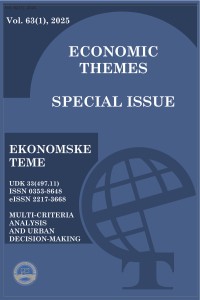Economic Themes (2025) 63 (1) 2, 23-43
Marta Hustava Sipulova, Claudia van der Laag Yamu, John Östh
Abstract: Although the Modified Areal Unit Problem (MAUP) is well-documented in spatial analysis, its effects on urban policy development and decision-making are yet unknown. So, we decided to do this work to critically investigate how MAUP influences urban planning at different levels, impacting analytical results, governance, and spatial policy. The arbitrary division of geographical units still introduces bias and uncertainty in decision-making procedures, even with growing computer capacity and extensive application of urban analytics. By using a semi-structured literature review, we studied current studies on MAUP in urban analytics and planning, therefore highlighting the importance of methodological techniques, difficulties, and mitigating methods. Our results show a fragmented corpus of research where methodological developments usually have no direct relevance for policy-making. We also underline the need for ex-ante and ex-post assessments to evaluate MAUP's influence on urban administration. Additionally, we emphasize the necessity of interdisciplinary collaboration to ensure a more holistic approach. We aim to raise awareness among urban designers, legislators, and researchers by bridging this research gap, thereby supporting more open, strong, and context-sensitive spatial decision-making systems.
Keywords: Modified areal unit problem; MAUP; urban analytics; urban decision making; urban policies; spatial analysis.
THE CONUNDRUM OF THE MODIFIED AREAL UNIT PROBLEM (MAUP) FOR URBAN DECISION-MAKING ACROSS SCALES: A CRITICAL REFLECTION
Marta Hustava Sipulova, Claudia van der Laag Yamu, John Östh
Abstract: Although the Modified Areal Unit Problem (MAUP) is well-documented in spatial analysis, its effects on urban policy development and decision-making are yet unknown. So, we decided to do this work to critically investigate how MAUP influences urban planning at different levels, impacting analytical results, governance, and spatial policy. The arbitrary division of geographical units still introduces bias and uncertainty in decision-making procedures, even with growing computer capacity and extensive application of urban analytics. By using a semi-structured literature review, we studied current studies on MAUP in urban analytics and planning, therefore highlighting the importance of methodological techniques, difficulties, and mitigating methods. Our results show a fragmented corpus of research where methodological developments usually have no direct relevance for policy-making. We also underline the need for ex-ante and ex-post assessments to evaluate MAUP's influence on urban administration. Additionally, we emphasize the necessity of interdisciplinary collaboration to ensure a more holistic approach. We aim to raise awareness among urban designers, legislators, and researchers by bridging this research gap, thereby supporting more open, strong, and context-sensitive spatial decision-making systems.
Keywords: Modified areal unit problem; MAUP; urban analytics; urban decision making; urban policies; spatial analysis.

